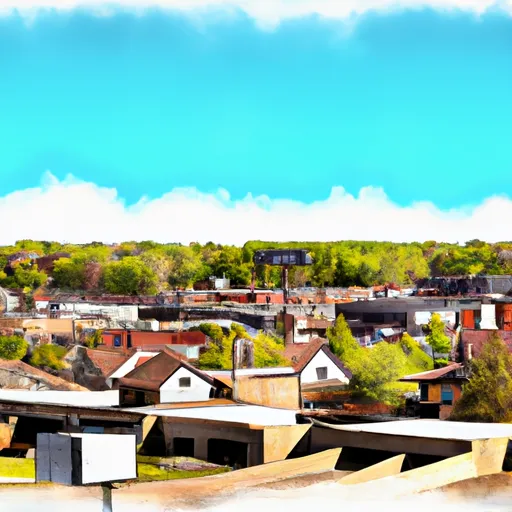-
 Snoflo Premium
Snoflo Premium
Get unlimited access to all our content
With no Ad interruptions! - Start Your Free Trial Login with existing account
Lowry
Eden Index
Climate
5.8
•
Recreation
1.0
•
Community
•
Safeguard
2.7/10

Lowry, Minnesota is a small town located in the heart of Pope County. The climate in Lowry is characterized by cold winters and warm summers, with an average temperature ranging from 15°F (-9°C) in winter to 80°F (27°C) in summer. The region experiences moderate rainfall throughout the year, with July being the wettest month.
Hydrology in Lowry is primarily influenced by the Chippewa River, which flows through the town. The river not only provides a picturesque landscape but also offers various recreational opportunities like fishing, canoeing, and kayaking. Anglers can expect to catch a variety of fish species, including walleye, northern pike, and smallmouth bass.
Surrounding Lowry, there are extensive natural areas and parks that offer outdoor enthusiasts a range of recreational activities. Lake Emily, located just a short drive away, provides opportunities for boating, swimming, and picnicking. Additionally, the Glacial Lakes State Trail offers scenic hiking and biking trails, showcasing the area's natural beauty and wildlife.
With its favorable climate, abundant water resources, and diverse outdoor recreation opportunities, Lowry, Minnesota is an ideal destination for those seeking to connect with nature and enjoy various outdoor activities.
What is the Eden Index?
The Snoflo Eden Index serves as a comprehensive rating system for regions, evaluating their desirability through a holistic assessment of climate health, outdoor recreation opportunities, and natural disaster risk, acknowledging the profound impact of these factors on livability and well-being.
Climate Health Indicator (CHI): 5.8
Lowry receives approximately
652mm of rain per year,
with humidity levels near 83%
and air temperatures averaging around
6°C.
Lowry has a plant hardyness factor of
4, meaning
plants and agriculture in this region thrive during a short period during spring and early summer. Most
plants will die off during the colder winter months.
By considering the ideal temperature range, reliable water supplies, clean air, and stable seasonal rain or snowpacks, the Climate Health Indicator (CHI) underscores the significance of a healthy climate as the foundation for quality living.
A healthy climate is paramount for ensuring a high quality of life and livability in a region, fostering both physical well-being and environmental harmony. This can be characterized by ideal temperatures, reliable access to water supplies, clean air, and consistent seasonal rain or snowpacks.
Weather Forecast
Streamflow Conditions
Minnesota
Area Rivers
Minnesota
Snowpack Depths
Minnesota
Reservoir Storage Capacity
Minnesota
Groundwater Levels
Recreational Opportunity Index (ROI): 1.0
The Recreational Opportunity Index (ROI) recognizes the value of outdoor recreational options, such as parks, hiking trails, camping sites, and fishing spots, while acknowledging that climate plays a pivotal role in ensuring the comfort and consistency of these experiences.
Access to outdoor recreational opportunities, encompassing activities such as parks, hiking, camping, and fishing, is crucial for overall well-being, and the climate plays a pivotal role in enabling and enhancing these experiences, ensuring that individuals can engage in nature-based activities comfortably and consistently.
Camping Areas
| Campground | Campsites | Reservations | Toilets | Showers | Elevation |
|---|---|---|---|---|---|
| Wolf Lake City Campground | 14 | 1,540 ft | |||
| Chippewa Co Park | 8 | 1,374 ft | |||
| Long Lake County Campground | 91 | 1,563 ft | |||
| Glendalough State Park | 22 | 1,350 ft |
Nearby Fishing
Catastrophe Safeguard Index (CSI):
The Catastrophe Safeguard Index (CSI) recognizes that natural disaster risk, encompassing floods, fires, hurricanes, and tornadoes, can drastically affect safety and the overall appeal of an area.
The level of natural disaster risk in a region significantly affects safety and the overall livability, with climate change amplifying these risks by potentially increasing the frequency and intensity of events like floods, fires, hurricanes, and tornadoes, thereby posing substantial challenges to community resilience and well-being.
Community Resilience Indicator (CRI):
The Community Resilience Indicator (CRI) recognizes that education, healthcare, and socioeconomics are crucial to the well-being of a region. The CRI acknowledges the profound impact of these elements on residents' overall quality of life. By evaluating educational resources, healthcare accessibility, and economic inclusivity, the index captures the essential aspects that contribute to a thriving community, fostering resident satisfaction, equity, and social cohesion.

